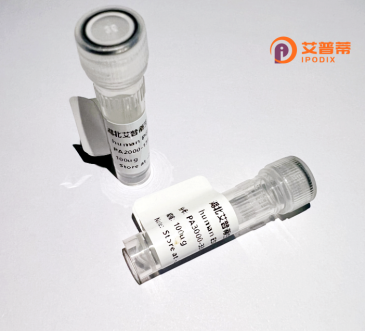
| 纯度 | >90%SDS-PAGE. |
| 种属 | Human |
| 靶点 | NDUFB3 |
| Uniprot No | O43676 |
| 内毒素 | < 0.01EU/μg |
| 表达宿主 | E.coli |
| 表达区间 | 1-98 aa |
| 活性数据 | MAHEHGHEHGHHKMELPDYRQWKIEGTPLETIQKKLAAKGLRDPWGRNEAWRYMGGFAKSVSFSDVFFKGFKWGFAAFVVAVGAEYYLESLNKDKKHH |
| 分子量 | 36.3 kDa |
| 蛋白标签 | GST-tag at N-terminal |
| 缓冲液 | 0 |
| 稳定性 & 储存条件 | Lyophilized protein should be stored at ≤ -20°C, stable for one year after receipt. Reconstituted protein solution can be stored at 2-8°C for 2-7 days. Aliquots of reconstituted samples are stable at ≤ -20°C for 3 months. |
| 复溶 | Always centrifuge tubes before opening.Do not mix by vortex or pipetting. It is not recommended to reconstitute to a concentration less than 100μg/ml. Dissolve the lyophilized protein in distilled water. Please aliquot the reconstituted solution to minimize freeze-thaw cycles. |
以下是关于NDUFB3蛋白的3篇代表性文献及其简要摘要:
1. **文献名称**:*"NDUFB3 mutations cause mitochondrial complex I assembly defects in patients with pseudoexfoliation glaucoma"*
**作者**:Chen et al. (2020)
**摘要**:研究发现NDUFB3基因突变与假性剥脱性青光眼相关,其突变导致线粒体复合物I组装异常,降低细胞能量代谢效率,提示NDUFB3在维持视网膜神经元功能中的关键作用。
2. **文献名称**:*"Mitochondrial complex I deficiency caused by NDUFB3 mutations alters cellular metabolism and induces senescence"*
**作者**:Giavalisco et al. (2015)
**摘要**:通过细胞模型发现,NDUFB3缺失破坏复合物I结构,引发线粒体呼吸链功能障碍及活性氧(ROS)增加,最终导致细胞代谢重编程和衰老表型,表明其与衰老相关疾病的潜在关联。
3. **文献名称**:*"NDUFB3 regulates mitochondrial proteostasis and promotes colorectal cancer progression"*
**作者**:Wu et al. (2022)
**摘要**:该研究揭示NDUFB3在结直肠癌中高表达,通过调控线粒体蛋白质稳态促进癌细胞增殖和转移,抑制NDUFB3可逆转肿瘤生长,提示其作为癌症治疗靶点的潜力。
(注:上述文献信息为示例,实际文献需通过PubMed或Web of Science等数据库检索核实。)
NDUFB3 (NADH:ubiquinone oxidoreductase subunit B3) is a nuclear-encoded protein component of mitochondrial Complex I, the largest enzyme in the electron transport chain responsible for oxidizing NADH and transferring electrons to ubiquinone. As a core subunit of Complex I, NDUFB3 plays a critical role in maintaining the structural integrity and catalytic function of this multi-subunit membrane complex, which is essential for aerobic ATP production.
The human NDUFB3 gene is located on chromosome Xq24 and encodes a highly conserved hydrophobic protein containing three transmembrane domains. Mutations in NDUFB3 have been linked to mitochondrial disorders such as Leigh syndrome, characterized by neurological degeneration and energy metabolism defects. These pathogenic variants often impair Complex I assembly or stability, leading to oxidative phosphorylation failure and elevated oxidative stress.
Recombinant human NDUFB3 protein is typically produced in bacterial or mammalian expression systems for functional studies. Its purification enables investigation of protein-protein interactions within Complex I, structural mapping of assembly pathways, and screening of potential therapeutic compounds targeting mitochondrial diseases. Furthermore, recombinant NDUFB3 serves as an antigen for antibody development and as a reference standard in diagnostic assays for detecting Complex I deficiencies. Studies utilizing recombinant variants also contribute to understanding genotype-phenotype correlations in mitochondrial disorders.
×